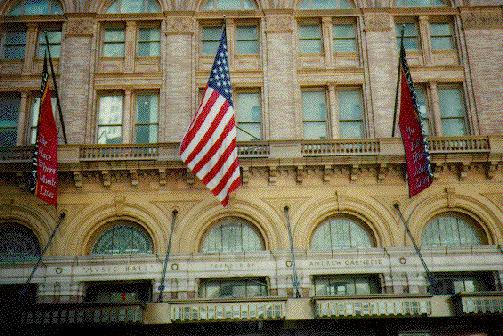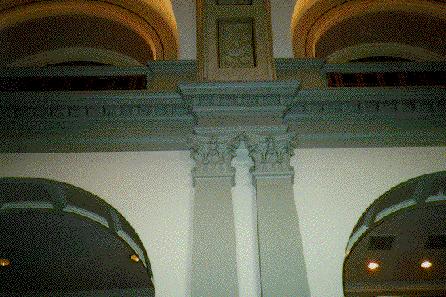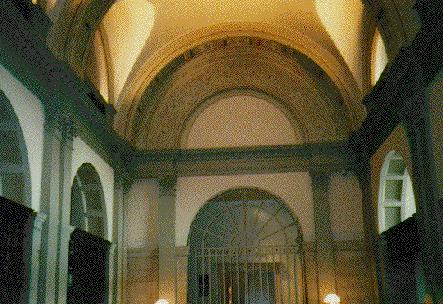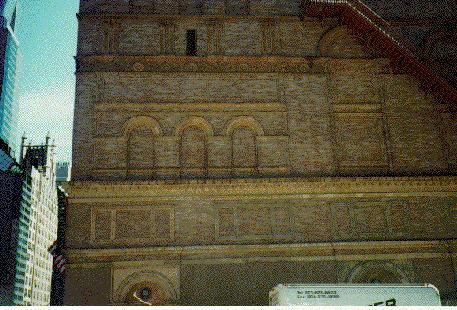|
Carnegie Hall
By Timothy B. Stevens
()

|
|
The Italianate Facade of Carnegie Hall
|
Background Information
Carnegie Hall is a concert hall located in New York City at Seventh
Avenue and Fifty Seventh street. Carnegie Hall opened in 1891
and is still used today. Over the last century many world renowned
artists have performed there including Peter Tchaikovsky, Igor
Stravinsky, and Maurice Ravel and George Gershwin. The Hall is
one of the most famous concert halls in the world. The acoustic
sounds are impeccable and the architecture is extravagant.
Purpose
After the Civil War the United States of America became transfixed
with music. New Yorkers were no exception. They got swept up in
the craze like everyone else. But there was a problem in New York.
The city did not possess a suitable concert hall. Being one of
the most important cities in the world, New York needed a top
notch place to play and listen to music. The city also needed
a place to serve as a cultural center. Carnegie Hall fulfilled
both of these needs.
Construction
Andrew Carnegie was one of the richest men at this time. He enjoyed
music just like everyone else. Carnegie agreed that that New York
City needed a concert Hall and decided to give money for this
purpose. He proposed this to the city administrators, they approved
of it and was in the works. Construction began on May 13, 1890.
Carnegie Hall was constructed over a span of seven years.
Architecture
The chief architect was William Burnet Tuthill. He was very interested
in the acoustics of the buildings. The sound quality in the hall
is first-rate. Tuthill chose the style for the building from
the Italian Renaissance. It is reminiscent of the Victorian age
because it is so elegant. The interior of Carnegie Hall is beautiful.
It contains marble in its foyer with great slanting arches in
the ceiling and the doors. In the corners of the foyer there are
columns with intricate carvings. This is apparent inside and
outside of the building. The exterior is comprised of bricks
which give the building a reddish hue. Both the inside and outside
had the look of sophistication. It attracted the richest people
and socially elite.
 |
 |
|
The internal elegance of the Hall
|
This building was constructed a few years before the steel era
which led to the construction of the sky scrapers that crowd the
New York sky line today. The method of building this hall was
strange because it is made up of three buildings. There is the
main hall which the show was actually performed. The second building,
also known as the "lateral" building, contained studios,
the recital hall and the chapter room, which was meant to be the
meeting place for different organizations. The third building
is more confusing than the other two. It is in between the other
two buildings.
In 1894, the building was extended to seventh avenue from fifty-sixth
street. and in 1896, the roof came off and a studio floor was
added on, while a ten story tower was constructed on the lateral
building. This extra construction made the building difficult
to navigate. Tuthill built Carnegie Hall so solidly that it was
meant to stand all of time.
The First Performer
The first performer at Carnegie Hall was a pianist named Franz
Rummel. He was a well known artist. He was just an average performer
with indifferent talents. The ironic thing about this was that
he did not perform on opening. He played one month before opening
night in the basement hall.
Opening Night Scares

|
|
The Hall on Opening Night, May 5, 1891
|
Opening Night was really on May 5. 1891. The performer was not
a no-name piano player. He was and is still one of the greatest
composer in the history of the world. The performer was Peter
Ilyich Tchaikovsky. The concert hall was jammed full of New Yorkers.
Tuthill was worried about this he did not believe that the steal
columns could withhold the mass weight of all of the people. He
left during the performance so he could examine the blueprints
of the building. Carnegie Hall remained standing that night and
is still standing today. It is still one of the most important
structures in all of New York.

|
|
The impressive brickwork
|
Bibliography
Schickel, Richard., The World of Carnegie Hall. (New York:
Julian Messner, Inc, 1960)
Links:
- [To be added later (possibly)]
[back to Medieval NewYork]
The Internet History Sourcebooks Project is located at the History Department of Fordham University, New York. The Internet
Medieval Sourcebook, and other medieval components of the project, are located at
the Fordham University Center
for Medieval Studies.The IHSP recognizes the contribution of Fordham University, the
Fordham University History Department, and the Fordham Center for Medieval Studies in
providing web space and server support for the project. The IHSP is a project independent of Fordham University. Although the IHSP seeks to follow all applicable copyright law, Fordham University is not
the institutional owner, and is not liable as the result of any legal action.
© Site Concept and Design: Paul Halsall created 26 Jan 1996: latest revision 12 April 2024 [CV]
|